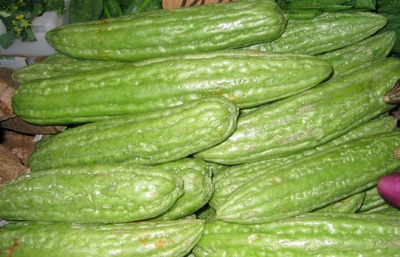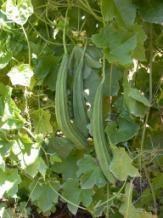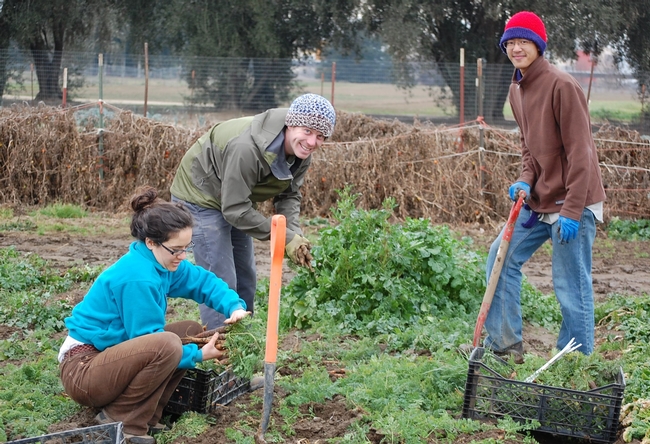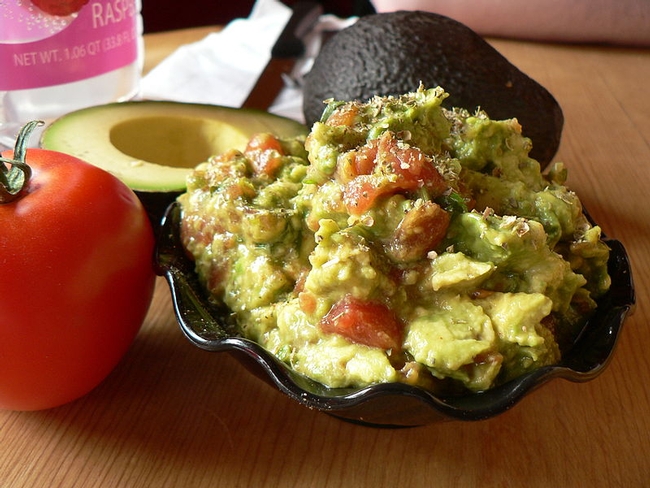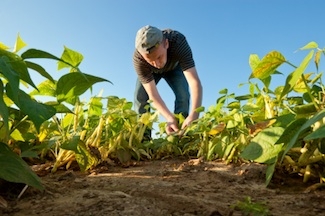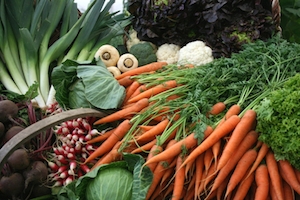UC Food and Agriculture Blogs
UCCE makes Southeast Asian vegetables easy to eat
Most Americans gravitate toward the familiar in supermarket produce aisles. But some creative shopping unveils a tremendous diversity of edible vegetables that can turn an ordinary menu into a much more interesting cuisine.
At certain roadside stands, at farmers markets that cater to diverse clientele and in small Asian supermarkets, adventurous Californians can buy vegetables like bitter melon, Chinese long beans, opo and luffa. Finding them is the first step, knowing how to prepare them is another matter. UC Cooperative Extension has made these less familiar vegetables more accessible by creating a collection of easy-to-cook and nutritious Southeast Asian vegetable recipes.
The recipes were developed by UCCE nutrition educators in Fresno and the statewide UC Expanded Food and Nutrition Education Program team with Richard Molinar, a UCCE advisor in Fresno County. Connie Schneider, director of the UC Youth, Families and Communities Program, and Molinar started by researching the traditional usage of Asian vegetables. They modified some ingredients and procedures in the recipes to simplify preparation and improve the nutritional profile.
“We minimized the number of ingredients in each recipe, added clear measurements and tested the dishes,” Schneider said. “They are delicious.”
For the last 18 years, Molinar has worked with small-scale farmers in Fresno County, which boasts the largest concentration of Hmong farmers in the U.S. Fresno County is also home to farmers of other ethnicities from Laos, China and Vietnam. Molinar and his assistant, Michael Yang, have introduced Southeast Asian immigrant farmers to the latest farming technologies, helped them develop plans to ensure the safety of the food they grow, and worked with them to find new marketing opportunities. Many of these farmers have begun growing vegetables common in California, and most have also kept some space on the farm for the vegetables of their homelands.
The UCCE educators recognized that the rich culinary traditions of local Southeast Asian immigrants could be adapted and used by people of all cultures to increase their consumption of vegetables. Besides, encouraging consumption of Southeast Asian vegetables adds new marketing opportunities for the farmers.
“This has been a unique opportunity to bring UCCE’s farm advisors and nutrition educators together to assist farmers and the public,” Molinar said. “These recipes will encourage more people to buy these nutritious vegetables, expanding the market for the growers.”
The 12 recipes are printed on cards, each with photos of the fresh vegetable and background information. For example, the recipe card for “bitter melon stir fry” notes that the crinkly skinned vegetable is native to India and is eaten when young and green, as bitterness increases with age. The recipe is accompanied by a photo of the prepared dish and complete nutrition facts per serving.
Most people are familiar with luffa after it has dried into a natural scrubby. It is often found near beauty products in stores and purchased to exfoliate the skin. However, the UCCE recipe card for “luffa and prawns” notes that fresh green luffa has a similar but sweeter flavor than zucchini summer squash when stir fried. Either the smooth or angled varieties of luffa can be used in the recipe.
"I grew up with zucchini," Molinar said, "but I prefer the flavor and texture of angled luffa."
The printed cards will be distributed at farmers markets where Southeast Asian vegetables are sold, and they are available on the Fresno County UC Cooperative Extension website. Farmers who sell Asian vegetables at farmers markets may pick up 10 packets of recipes for free at the UC Cooperative Extension in Fresno, 1720 S. Maple Ave., Fresno. Direct links to each of the recipes are below:
- Bitter Melon Stir Fry
- Chinese Long Bean and Tofu Salad
- Chinese Winter Melon Chicken Soup
- Field of Greens Salad
- Fuzzy Gourd Stuffed with Pork and Mushrooms
- Lemongrass Chicken Soup
- Luffa and Prawns
- Marinated Japanese Eggplant
- Opo and Beef
- Snow Pea Daikon Salad
- Strawberry Spring Rolls
- Spicy Shrimp and Bok Choy Noodle Bowl
Following are two sample recipes:
Bitter Melon Sir Fry
Serves 4
Ingredients:
1 ripe bitter melon, seeded and sliced
1 tablespoon olive oil
1 onion, diced
3 garlic cloves, crushed
½ lb. ground pork
½ lb. medium shrimp, peeled and deveined
1 tomato, chopped
1 tablespoon reduced sodium soy sauce
Pepper to taste
Directions:
- Place sliced bitter melon in boiling water until just tender (2-3 minutes). Drain
- Heat olive oil in skillet over medium heat. Sauté onions for about 5 minutes until tender.
- Add garlic; sauté an additional 2 minutes; mix in pork and cook until no longer pink.
- Add shrimp; cook about 5 minutes until done.
- Add tomato, bitter melon, and soy sauce; cook until tender.
Luffa and Prawns
Serves 4
Ingredients:
1 tablespoon vegetable oil
1 garlic clove, minced
1 lb large prawns, peeled and deveined
2 luffa (angled luffa or smooth luffa), chopped
¼ cup bamboo shoots
1 teaspoon coriander
1 tablespoon reduced sodium soy sauce
1 green onion, sliced
Directions:
- Heat oil in a wok/pan; add garlic and stir fry for 1 minute.
- Add prawns; cook until done
- Add luffa; continue to stir fry with prawns until just tender, about 5 minutes.
- Add bamboo shoots, coriander, and soy sauce to pan and stir fry a few minutes
- Sprinkle with green onion and serve.
Videos explore the future of farming
Pop quiz: About 7 billion people live on earth today, and that number is expected to hit 9 billion by 2050. That’s a lot of mouths to feed. What’s the best way to reform our global food production to meet the rising demand?
- Invest in technology, plant breeding, soil science and seed genetics to make our finite farm land more productive.
- Increase sustainability, so farm land can remain productive in the future.
- Encourage more people to get into farming.
- Help farmers manage climate change, water supply and pest control.
- All of the above and a whole lot more.
Yep, the answer is e. All of the above and a whole lot more. Many of the challenges and solutions are explored in a new video series on YouTube called "9 Billion Mouths to Feed: The Future of Farming."
Produced by UC Davis in cooperation with University of California’s "UCTV," the four 10-minute videos provide an excellent overview of modern problems facing our food supply.
"There’s a growing population and we’re going to need to produce more food in a sustainable way to feed them all," says Genevieve Lipari, a UC Davis student featured in the videos. “And it’s not just agriculture, it’s food access, health, nutrition and so much more.”
Indeed, agriculture isn’t just about sowing the land. The videos bring that fact to life, showing the work California farmers and UC Davis students and researchers are doing to ensure an abundant food supply that’s healthy, tasty and safe.
The videos are perfect for students young and old, and anyone interested in finding innovative ways to feed the world without depleting our limited resources.
We might not have all the answers on how to feed a growing population, but the videos shine light on some of the many farmers, scientists and students working together to try to meet that growing need.
You can watch “9 Billion Mouths to Feed” at www.uctv.tv/farming
Super ways to eat healthy on game day
Super Bowl Sunday is one of the biggest eating days of the year — right up there with Thanksgiving.
Enjoy the party without over indulging. Here's how:
Pre-game warm-up: Eat a healthy breakfast and lunch or snack before you head to the party. Skipping meals to “save up” your calories for the big event backfires when you over eat because you are so hungry.
Think like a winner: Focus on the game and enjoying your friends, rather than on the food.
Have a game plan: Take a look at the food spread before digging in. You don't have to eat some of everything — choose 2 to 3 foods you really like — maybe something you seldom eat (you can eat chips anytime). Take small servings then fill up your plate with healthy items like fruit and veggies (but go easy on the dip — just 1 tablespoon typically has a 100+ calories!)
Follow a winning strategy: Eat mindfully — think before you put something in your mouth. After serving your plate, move away from the buffet table where it's easy to eat lots of guacamole and chips (without even thinking about it) while you're standing there watching the game.
Take a break at half-time: Grab a friend or two and take a walk in the neighborhood. You'll gain energy and be ready to tackle the second half of the party.
Keep advancing toward the goal line: Regular soda, lemonade, beer and cocktails can add lots of extra calories. Drink light versions of your favorite beverages. If you indulge in cocktails, limit the calories by limiting yourself to two drinks — one each half, and drink water the rest of the time.
Avoid time-outs: Don't let food-borne illness ruin your game. Avoid eating perishable foods that have been left out at room temperature for more than two hours. That includes things like chicken wings, nachos with chicken or beef, barbeque sliders, dips made with sour cream, and cut fruits and vegetables (unless served on ice).
Score the winning touchdown! Make healthy choices and have a great time.
How do you put on a Super Bowl spread that's healthier for your family?
Beyond manifesto: How to change the food system
Mark Bittman, cookbook author and New York Times food writer, used the occasion of New Year’s Day to throw down the gauntlet for real and permanent change to the U.S. agricultural system. “We must figure out a way to un-invent this food system,” he says in a Times opinion column. He likens the scale of the task to tectonic cultural strides like abolition, civil rights, and the women’s vote.
As to how we go about achieving this goal, Bittman speaks in broad terms. He appeals for patience, invoking the pioneers of those transformative movements, who had the perspective that their progress is not just for now but for future generations. He names the culprits of sugary drinks and poor livestock conditions as key points of attack. He calls for goals. Well reasoned approaches, to be sure, but they aren’t a blueprint for specific action.
UC Berkeley researchers have been working on some specifics for several years now, researching the agricultural, policy, and social practices that would make possible the type of systemic change Bittman is advocating. In a special multi-article feature devoted to "diversified farming systems," or DFS, for the December issue of the journal Ecology & Society, scientists from Berkeley, Santa Clara University, and other institutions lay out a comprehensive scientific case that biologically diversified agricultural practices can contribute substantially to food production while creating far fewer environmental harms than industrialized, conventional monoculture agriculture—that is, large swaths of land devoted to growing single crops using chemical inputs.
DFS are different from the narrow definition of organics, and the research shows that, unlike industrial agriculture, biologically diversified agriculture tends to generate and regenerate ecosystem services such as soil fertility, pest and disease control, water-use efficiency, and pollination, which provide critical inputs to agriculture. The research also found that DFS support globally important ecosystem services, including substantially greater biodiversity, carbon sequestration, energy-use efficiency, and resilience to climate change.
But changing America’s agriculture system is more complex than just changing farming techniques, according to Alastair Iles, assistant professor of environmental science, policy, and management, and co-director of the Berkeley Center for Diversified Farming Systems.
“If diversified farming systems are to thrive in the United States, policies and preferences must evolve to reward the environmental and social benefits of sustainable farming and landscape management,” Iles says. “Policies supporting ecological diversification are underdeveloped and fragmented compared with conventional agricultural policies.”
In one Ecology & Society article, Iles and co-author Robin Marsh, also of UC Berkeley, consider several obstacles that prevent or slow the spread of diversified farming practices, such as the broader political and economic context of industrialized agriculture, the erosion of farmer knowledge and capacity, and supply chain and marketing conditions that limit the ability of farmers to adopt sustainable practices.
“To transform agriculture, we need to understand these obstacles and develop and test solutions, such as peer-to-peer learning, recruitment and retention of new farmers through access to credit and land, and compensation for ecological services provided by ranchers, for example,” Iles says.
Other key facets of a sustainable agricultural system include attention to its social dimensions, such as human health, labor, democratic participation, resiliency, diversity, equality, and ethics, according to special issue co-editor Chris Bacon of Santa Clara University. In an article with colleagues, Bacon proposes creating partnerships with institutions that could address issues like immigration, food access, and worker health.
But first and foremost, the farms themselves have to produce enough to remain profitable and to feed a growing population. Conservation biologist Claire Kremen, also a UC Berkeley professor and co-director of the Berkeley DFS Center with Iles, says that more work is needed to build on what is already known about biologically diversified agriculture, to make them these methods even more productive.
“To date, the amount of research and development investment in this type of agriculture is miniscule compared to what’s been invested in conventional agriculture,” Kremen said. “There may be substantial potential to increase food production from biologically diversified, sustainable agriculture that we have not yet tapped into. With research support to study and improve on sustainable farming systems, we can tap that potential. Growers want to utilize sustainable practices if they can, but they need to know it won’t hurt their bottom line.”
So, DFS scientists might argue, Bittman’s New Year’s manifesto, which ends with a call for “energy, action — and patience,” could be amended to include “a comprehensive scientific, political, and sociological approach, and putting dollars behind the right kinds of research.”
Read more about diversified farming systems research at UC Berkeley.
Nominate a farmer or an educator for a Pedro Ilic Award
Calling all small-scale farmers and their supporters! Now is the season of awards and conferences in the agricultural world — and that goes for small-scale farmers too. At the moment, we are seeking nominations for the Pedro Ilic Awards, which honor dedication to small-scale farming.
These awards are named for Pedro Ilic, Fresno County small-scale farm advisor, whose death in 1994 prompted the UC Small Farm Program to annually honor those who carry out his legacy of personal commitment to small-scale and family farming. Ilic was one of the original advisors when the Small Farm Program was established in 1979.
Each year, the awards honor an educator and a farmer who embody characteristics that helped make Ilic a success.
Anyone can write a nomination. Take a look at the nomination form, which is now online. The deadline for nominations is February 4.
The awards will be presented at the California Small Farm Conference, March 10-12 in Fresno.
This conference, which rotates location each year, is the state's premier gathering of small farmers, agricultural students, farmers market managers and others involved in the small-farm industry. The three-day educational conference includes day-long short courses and on-farm tours; 25 focused workshops; keynote addresses and many networking opportunities.
Do you know an outstanding farmer or agricultural educator? Honor him or her with a nomination for the Pedro Ilic Award!



